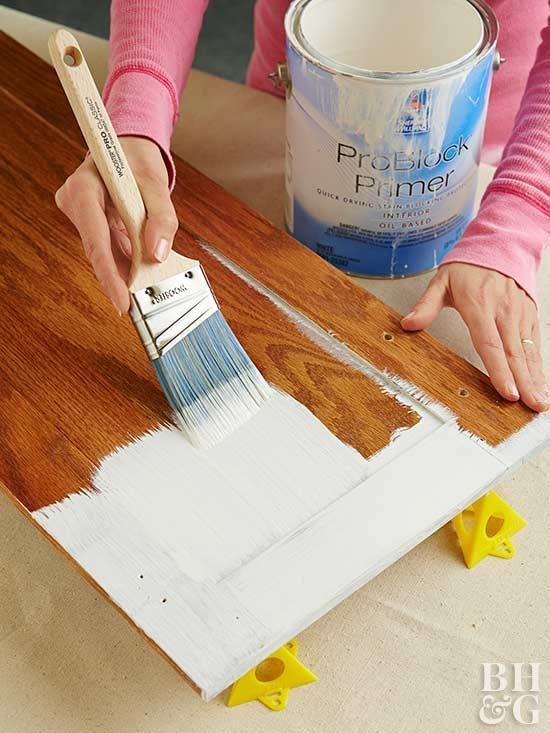Primers and sealers, are they necessary?
Primers and sealers, are they necessary?
Yes, primers and sealers are very important.
What is a sealer?
Sealers, closely related to primers, are formulated to make a porous surface non-porous. They are also used to cover knots and mildew to keep them from showing through the finish coats. You’ll find oil-base sealers, as well as products with reactive resins and epoxies. Most of these products clean up with strong petroleum solvents. Use sealers when working with the following surfaces:
- Any unpainted surface, including new plaster, drywall, and old woodwork that has been stripped.
- Bare open-grained woods such as oak and maple.
- Bare woods, such as redwood, that bleed through or discolor paint.
- Large areas of wallboard joint compound or patching plaster.
- Masonry surfaces like unglazed brick, cinder block, and concrete.
- Metal surfaces; use an oil-based primer-sealer with rust inhibitors to prevent corrosion.
What is a primer?
Primers and sealers provide an extra measure of assurance that the paint you use will adhere to its surface. In effect, primers and sealers are preparatory products that give the surface tooth that the paint can grip. Because of their importance, there are aisles dedicated to primer and sealers at the hardware store. To figure out what you’re looking for, check out our guide to paint primers and sealers. We’ll help you get the job done right, the first time.
On raw interior wood, oil-base primers may be a better choice because of their surface penetration. On the exterior, a latex primer will last longer because it’s more flexible, expanding and contracting with changes in temperature instead of cracking. There are a number of different kinds of primers—oil-base, shellac-base, water-base—and each has its own specialty. Ask your retailer for a recommendation on which product to use on the surface you’re painting.

Choosing the Right Primer or Sealer
Primers and sealers come in an array of formulations. It’s important to choose the right one for your job.
Exterior Applications
- New unpainted wood: If the wood species won’t leech tannins into the paint, use either a quality acrylic latex or an oil-base exterior wood primer. For woods that will stain the paint, apply an oil-base stain-blocking primer. Prime and paint bare wood within two weeks of installation to prevent the wood fibers from deteriorating and reducing adhesion.
- Weathered, unpainted wood: Sand the wood thoroughly before priming to remove deteriorated wood fibers, which will compromise primer adhesion. Remove the dust, then apply a quality latex or oil-base primer shortly after preparing the surface.
- Painted wood: Scrape all loose paint and feather-sand rough edges. Sand bare spots, remove all chalking with a damp cloth, and let the surface dry. If you can’t remove all the chalk, apply an oil-base primer. If the old paint is sound and adhering well, priming can be beneficial but is not necessary.
- Masonry: On new masonry, or older porous surfaces, use a latex masonry sealer or primer. On previously painted masonry, you need to seal only spots where the old paint has been removed during surface preparation or by weathering.
- Aluminum or galvanized iron: Remove any white, powdery oxide using a nonmetallic scouring pad or abrasive. Then apply a corrosion-inhibitive metal primer to all exposed bare metal.
- Ferrous metals: Wire-brush any rust, rinse, let dry, and apply two coats of a latex or oil-base rust-inhibitive primer.
Interior Applications
Most interior primers are designed for specific applications and come in both latex and oil-base formulations. You may prefer latex products because the reduced odors are an advantage when working indoors.
- Drywall primers: While these products are called primers, they actually serve as pigmented sealers over drywall to give the topcoat of paint a smooth surface to adhere to. This results in a uniform appearance. They also enhance the hiding ability of the finish coat by providing additional tinting in the undercoat.
- Stain-blocking primers: These primers stop bleed-through of such stain-producing agents as dirt, ink, crayon marks, smoke residue, grease, mildew, and water stains. Both latex and oil-base products are available, but oil-base products are more effective for blocking water stains. Shellac-base stain-blocking primers are heavily tinted to keep mildew from bleeding through the paint. Always wash mildewed areas thoroughly with a mild bleach solution, allowing the solution to remain on the surface for 20 minutes. Let the area dry before priming it.
- Vapor barrier primers: These primers are useful in bathrooms, kitchens, and other rooms that can harbor moisture. In rooms without plastic vapor barriers in the walls, these primers help minimize the passage of the moisture through the walls to the exterior, thereby reducing the likelihood the moisture will push the paint off the outside walls. Because they retain humidity, they also help keep indoor rooms more comfortable in winter.
- Latex enamel undercoaters: Using these primers under semigloss or gloss paint helps ensure that the topcoat of paint will develop its maximum gloss and have a uniform look. For best appearance, some manufacturers recommend a light sanding on the undercoat before applying the paint.
- Bonding primers: These primers are designed for slick surfaces such as glass, ceramic tile, and synthetic laminates. Sand the surface first with fine (220-grit) aluminum oxide sandpaper to improve adhesion.
- Concrete primer/sealer: Use this product to reduce the dust on interior concrete floors and to smooth the porous surface.


